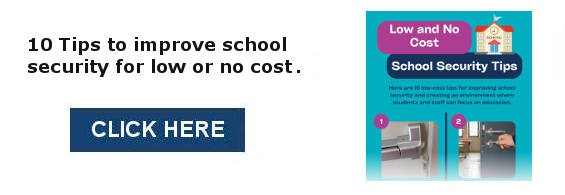It seems that our children’s summer vacations are getting (or feeling) shorter these days. As we enter another school year, the feelings today’s parents have are likely very different than those our parents or grandparents may have had as they watched their own children step onto the bus or walk away from the car drop-off line. It is now commonplace for a parent to feel anxious or nervous throughout each day of the school year, waiting for their child to come home from a place that was once deemed the most secure place a child could be.
I have taken on multiple roles in the world of school security. As a former school resource officer with a background in digital and social media investigations, I educated students, parents, and staff on the importance of online safety. I prioritized how to identify, report, and respond to a potential threat made on a digital platform, and showed students and parents how they can use the internet as a positive social tool. In my current role as a school security assessor and CPTED (Crime Prevention Through Environmental Design) practitioner, I observe the physical aspects of school security both inside the building and on the exterior. I work with staff, administration, and local school boards to maximize security measures that are already in place and to implement new steps towards greater school security. On a personal level, as the mother of a toddler and stepmother of a middle schooler, I do everything I can to ensure the safety of my own children.
Unfortunately, school violence is increasing. The 2021-2022 school year alone saw a nationwide 311% increase in gun violence issues over the prior school year. With my mix of professional and personal interest in school safety, I am devoted to continuing to educate others on the steps they can take to bolster school security and to prevent another tragedy from occurring.
I recently devised a framework to help parents as they navigate this tricky terrain. The ADEPT framework includes five steps that will help parents become more adept at understanding and supporting school security.
The ADEPT Framework: Five Practical Steps Parents Can Take to Assess School Security
- Ask about the school’s emergency and crisis guidelines. Find out from the administration if the school officials test and exercise crisis guidelines. Does the school have a lockdown procedure? Do they conduct periodic drills to practice the procedures? What other security protocols are in place?
Researching your state’s requirements on lockdown drills can give you guidance on what your child’s school should be doing in this regard, and how often these drills should be practiced. For example, the Commonwealth of Virginia requires a lockdown drill at least once in the first 20 school days each year. Subsequent to the first drill, at least one additional drill should be performed after the first 60 days.
Another question to ask is whether the school has a lockout policy. A lockout drill is used to secure the school building from a potential threat in the surrounding area (e.g., if there is serious criminal activity occurring in a nearby neighborhood). During a lockout, access to the building is restricted, but there can be limited movement within the building, such as class changes. In most situations, schools will provide parents with a written notice or phone call notification of the event and how the situation was resolved. Ask what the school is prepared to do in the event of different types of emergency situations. If evacuation is necessary, find out if your school has a detailed reunification plan in place for parents looking to pick up their child.
- Determine if all school employees (to include support personnel and school security) have received training on crisis preparedness issues. In addition to understanding the school’s written guidelines on emergency and crisis planning, it is important to know whether or not the employees have been trained on what to do in these situations. Are all employees, including support personnel such as secretaries and custodians, included in such training? This is an important question to ask as a child may be in the hallway or otherwise away from a classroom when a crisis occurs. Do school bus drivers receive training in crisis preparedness? School bus drivers are typically required to complete extensive training before driving. In most districts, this includes ways to handle emergency situations. Bus drivers face the same types of emergencies and threats that can occur on a school campus. It is important to know that if a threatening (or even a medical) emergency arises, the bus driver is equipped to handle the situation.
Also determine if there is a school security officer present on school grounds. It's important to understand what kind of training the security officer has, whether or not they are armed, and what their role is in the event of an actual emergency. It is also a good idea to find out how frequently officer training is provided. A new school year often brings about changes in policy that could require additional training. All employees, to include school security officers, should be up to date on state requirements for training and should be knowledgeable of all applicable policies for crisis and emergency planning.
- Examine the access into your child's school. As you approach the school, observe the number of doors that allow access from the outside in. There should be one main entrance at the front of the school, while secondary doors to the outside should be electronically locked and allowing egress only (i.e., no entry). Are there clear, concise signs stating where the main entrance is and is it clear that visitors are expected to access the school through this main entrance?
Inside the main entrance, there should be a vestibule that separates the interior of the school from the outer door. On the exterior of the building or in the vestibule, is there an intercom that allows for audio and/or visual communication to the main office? This allows school employees to help the visitor without granting access, or to direct visitors with a legitimate need to the main office. It is important to remember, and to teach your child, that each individual must check in prior to entering the school building, and that the door should not be held open for anyone.
- Perceive the level of threat readiness. Does the school have a threat assessment team, and if so, who is on the team? A threat assessment team is an interdisciplinary team of school administrators, guidance counselors, psychologists, social workers, and school resource/school security officers. Parents should ask questions about what the threat assessment protocol includes, and who is responsible for conducting the threat assessment. A school-employed mental health professional should be involved in the development and implementation of this protocol. The assessment protocol should include identifying student threats, determining the seriousness of the threat, and developing intervention plans to protect potential victims and to address the underlying problem or conflict that motivated the threatening behavior. If you, as a parent, do not perceive that the school is sufficiently ready to respond to a threat, discuss your concerns with the administration in a productive, non-accusatory manner.

Threat Assessment Team Discussing a Concern
- Talk with your child(ren) early and regularly about safety risks. Communication is key, and when you talk with your child, BE HONEST! Does your child have at least one adult in the school they feel comfortable reporting concerns to? Encourage your child to report unsafe or potentially dangerous situations to an adult in their school.
Don’t assume that your child knows even the basic facts about safety and risk. Children absorb a lot of information from a vast number of sources, including social media platforms. It is important for parents to discuss the information they are hearing and to help relay age-appropriate and correct information in a calm and supportive manner. Being open and trustworthy in these types of situations helps your child know they can come to you later on with any questions or problems.
It is important for parents to learn and understand what is happening in their child’s school regarding school safety. It is easy to get caught up in the negative news that is paraded into our homes on a constant basis. But I believe we can all take steps to be part of the solution.
I hope the ADEPT tips I have provided can help parents take proactive steps to partner with schools in making school security a top priority. This is important not only for everyone’s safety, but so that parents can feel comfortable entrusting their child to the school each day. Our children are our most precious assets, and by working together we can bring safety to the forefront of education.



.png)

-1.jpg)
.jpg)
.jpg)
.jpg)
-2.jpg)
.jpg)
.jpg)
.jpg)
.jpg)
.jpg)

